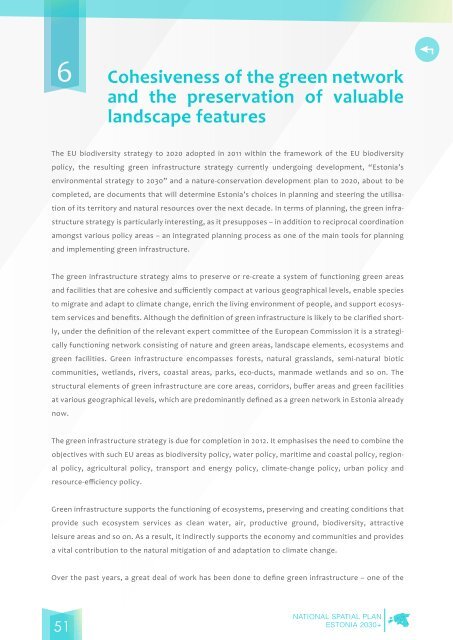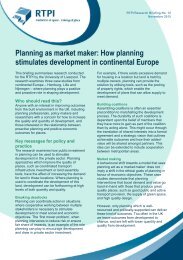estonia-2030_en
estonia-2030_en
estonia-2030_en
Create successful ePaper yourself
Turn your PDF publications into a flip-book with our unique Google optimized e-Paper software.
6Cohesiv<strong>en</strong>ess of the gre<strong>en</strong> networkand the preservation of valuablelandscape featuresThe EU biodiversity strategy to 2020 adopted in 2011 within the framework of the EU biodiversitypolicy, the resulting gre<strong>en</strong> infrastructure strategy curr<strong>en</strong>tly undergoing developm<strong>en</strong>t, “Estonia’s<strong>en</strong>vironm<strong>en</strong>tal strategy to <strong>2030</strong>” and a nature-conservation developm<strong>en</strong>t plan to 2020, about to becompleted, are docum<strong>en</strong>ts that will determine Estonia’s choices in planning and steering the utilisationof its territory and natural resources over the next decade. In terms of planning, the gre<strong>en</strong> infrastructurestrategy is particularly interesting, as it presupposes – in addition to reciprocal coordinationamongst various policy areas – an integrated planning process as one of the main tools for planningand implem<strong>en</strong>ting gre<strong>en</strong> infrastructure.The gre<strong>en</strong> infrastructure strategy aims to preserve or re-create a system of functioning gre<strong>en</strong> areasand facilities that are cohesive and suffici<strong>en</strong>tly compact at various geographical levels, <strong>en</strong>able speciesto migrate and adapt to climate change, <strong>en</strong>rich the living <strong>en</strong>vironm<strong>en</strong>t of people, and support ecosystemservices and b<strong>en</strong>efits. Although the definition of gre<strong>en</strong> infrastructure is likely to be clarified shortly,under the definition of the relevant expert committee of the European Commission it is a strategicallyfunctioning network consisting of nature and gre<strong>en</strong> areas, landscape elem<strong>en</strong>ts, ecosystems andgre<strong>en</strong> facilities. Gre<strong>en</strong> infrastructure <strong>en</strong>compasses forests, natural grasslands, semi-natural bioticcommunities, wetlands, rivers, coastal areas, parks, eco-ducts, manmade wetlands and so on. Thestructural elem<strong>en</strong>ts of gre<strong>en</strong> infrastructure are core areas, corridors, buffer areas and gre<strong>en</strong> facilitiesat various geographical levels, which are predominantly defined as a gre<strong>en</strong> network in Estonia alreadynow.The gre<strong>en</strong> infrastructure strategy is due for completion in 2012. It emphasises the need to combine theobjectives with such EU areas as biodiversity policy, water policy, maritime and coastal policy, regionalpolicy, agricultural policy, transport and <strong>en</strong>ergy policy, climate-change policy, urban policy andresource-effici<strong>en</strong>cy policy.Gre<strong>en</strong> infrastructure supports the functioning of ecosystems, preserving and creating conditions thatprovide such ecosystem services as clean water, air, productive ground, biodiversity, attractiveleisure areas and so on. As a result, it indirectly supports the economy and communities and providesa vital contribution to the natural mitigation of and adaptation to climate change.Over the past years, a great deal of work has be<strong>en</strong> done to define gre<strong>en</strong> infrastructure – one of the51




